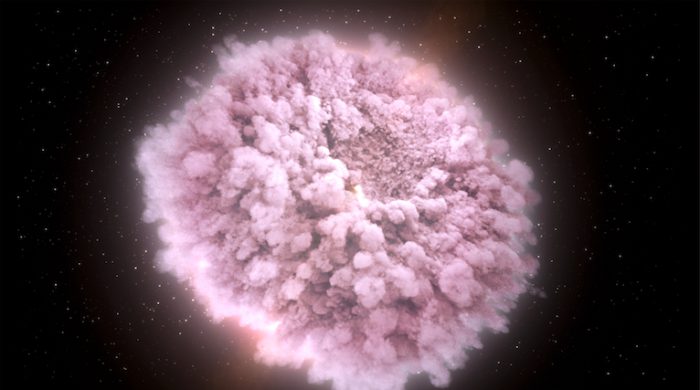Scientists have confirmed that on August 17, they captured the sounds and sights of one of the universe's mightiest explosions. A kilonova, or the collision of two neutron stars. It is the first time that such a moment has been viewed by humans. To understand better what happened with this event, known as of GW170817, let's quickly take a closer look at our cast...
Neutron star
When a massive star collapses near the end of its life, it creates a huge explosion called a supernova. Often, only the core of the star is left behind. The larger cores become black holes. The smaller cores, however, become neutron stars. These are the densest visible objects in the universe. If you could scoop up a teaspoon of it, it would weigh as much as Mount Everest.
Binary buddies
Binary just means "two" or "a pair". A binary star is actually two stars orbiting one another. A binary neutron star is, yep, two neutron stars orbiting each other. And that's what GW170817 was before it went BOOM! in a...
Kilonova
Like a supernova, a kilonova is a huge explosion that releases massive amounts of energy into the universe. Except it happens when two neutron stars collide. (It can also happen when a neutron star and black hole collide.) So back to GW170817... What happens when a binary neutron star goes kilonova? We have two versions for your viewing pleasure! First, the flashy animated version...
And now, what we actually observed here on Earth. The kilonova appears to the top left of the galaxy in the centre, NGC 4993. First it appears white (0:01), before turning to a soft red (0:12), and fading away altogether.
Okay, sure... The first one is cooler! But remember, though obviously small on the second video, the light you see here is from an explosion that happened both far away and long ago. 130 million years ago, in fact! (Remember, one light year is the distance light travels in a year, about 9.4 trillion km or 6 trillion miles.)
Ride the waves
As we mentioned earlier, this event was heard as well as seen. Kilonovas release something called gravitational waves. These ripple away from the explosion like waves do after a pebble is thrown in a pond. The waves can actually be heard as they wash toward and past us, and sound a lot like a digital chirp! Human beings have only been able to measure gravitational waves for about 15 years. Until now, the only waves that we had recorded came from collisions between two black holes. Those are the first five entries on the video below. From start to finish, most of those chirps don't even last a full second. But at the bottom, you'll hear GW170817. It lasts about 100 seconds! Listen for yourself (it begins as a very low frequency).
Why is this one so much longer than the others? That's still a puzzle for scientists to unravel. But knowing that we're listening to and seeing an explosion that first happened when dinosaurs walked the Earth, and from a part of the universe 1,230 trillion kilometers away? Science rules!
 An artist's interpretation of the moment right before a kilonova. Scientists believe that much of the universe's heavy elements, such as gold and platinum, are formed in these clouds of debris. We're rich! (NASA Goddard Space Flight Center/CI Lab)
An artist's interpretation of the moment right before a kilonova. Scientists believe that much of the universe's heavy elements, such as gold and platinum, are formed in these clouds of debris. We're rich! (NASA Goddard Space Flight Center/CI Lab)









